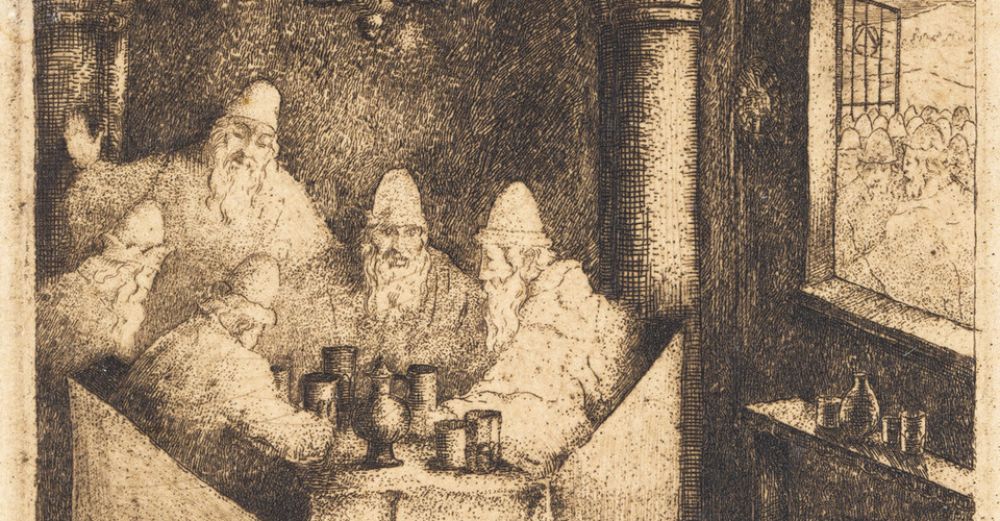- News
- Events
- Oneg Shabbat
- Collections
- Research
- Exhibitions
- Education
- Publishing Department
- Genealogy
- About the Institute
- Bookstore


Passover is approaching. This year it starts on th evening of the 25thof March and will last until the 2ndof April. It is a very old holiday, described in the Torah (Bible) and regarded as one of most important in Judaism. It is told to be the holiday of freedom because it commemorates the exit (Exodus) of Jews from Egyptian slavery. During their journey to the Promised Land, Jews have been granted full identity as a nation bound by extremely important ideas: faith in one God, commandments of ethical nature and a sense of chosenness.
Where is the word coming from? “Passover” in Hebrew means “to pass.” The Jews lived in Egypt for a few hundred years,but the next ruler decided to make them slaves, which forced them to slave labor. Moses wanted to walk the Jews out of Egypt with the permission of the Pharaoh, which he finally promised them. Unfortunately, the Pharaoh did not keep his promise and so God started to harass the Egyptians with plaguess. All plagues were severe (eg. plague of locusts or plague of darkness), but the worst was the last — the death of the firstborn, people and animals. Moses received a hint from God that the Jews should mark the doors of their houses with blood of the lamb so that the angel of death passed their houses, and only punish the Egyptians. Thanks to that, the Jewish firstborn did not die.
Celebrating the Passover is a complicated and requiring a great attention to detail rite. Interestingly, it does not take place in a synagogue, but at home and it is a ceremonial dinner called Seder, that takes place in the first night of the holiday. It is however preceded by lots of preparations.
First of all there cannot be even a crumb of bread in a whole house, becausein addition to generally applicable rules of kashrut, during the eight days of Passover no acidic or fermentable products cannot be eaten or possesed. Of breads, only matzah, thin wafers (unleavened bread) kneaded with flour and water, can be eaten (preparation of matzah dough can not take longer than 18 minutes). It is done so because the Jews escaping from Egypt had to make bread in a hurry and could not wait for it to grow.
This prohibition entails a need for thorough orders. Spring cleaning is a tradition known in other cultures, but does any of them knows so effective psychological justification for the necessity of their performing?
Children also participate in cleaning, usually for the smaller ones left is a handful of crumbs, so they could find it a day before the holiday and together with their father ceremoniously burn them. Other acidic products can be symbolically sold to non-Jewish neighbors.In any case, each of the many rituals, commands and prohibitions during Passover is symbolic and refers to specific event in history. Everyone should feel as though they experienced the Exodus.
Seder (in Hebrew, “order”) isactually carried out according to a specific order. On table, there are three matzah covered with a decorative napkin (symbol of the old structure of the Jewish community — the priests, the Levites, and the people). Among Seder dishes, have to be found bitter herbs (they symbolize taste of tears of Jews in Egyptian slavery); baked egg sprinkled with ash (symbol of collective destiny of the nation and the strength to survive); grated apple salad with crushed almonds, walnuts and wine (it should resemble the appearance of clay, from which the Jewish slaves were making bricks); roasted leg of lamb (resembles old victims in the Temple), four glasses of wine. At the center of the table stands a large cup designed for the prophet Elijah, who is considered the guardian spirit of the nation of Israel.
During supper, the Haggadah for Pesach is read. There are different versions of Haggadah, which is not a liturgical text, but they have similar content. Quotations from the Bible are about the fate of the Jews in Egypt, the decision to leave the country, the ten plagues of Egypt, the miracles that God allowed Moses to do during the flight (although Moses’ name does not appear in the Hagadah, in order to avoid assigning merit proper only to God). In Haggadah there are many popular folk themes, such as the song about the kid „Chad Gadya.”
During the feast four cups of wine are drank to commemorate the four sentences, which God promises to the Israelites’ liberation; drops of wine are spilled ten times in remembrance of the ten plagues. One of the youngest children asks questions about the importance of rites of Passover, to which responds to the head of the family. Then revelers sing shortened versions of the Halel praises, not to show too much joy since many Egyptians have been killed in the waves of the Red Sea when chasing the Jews, and other hymns and songs. Seder ends late at night. Participants wish each other „next year in Jerusalem,” because for 2000 years Jews have been longing for that city and of returning there they could have only dreamed.